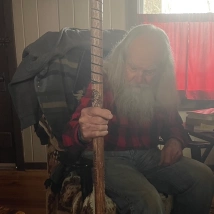admin
December 16, 2022
A Look at Coal Mining in Alabama
By: Lily McCormick
For William Thorton, his coverage of the Warrior Met Coal Strike began as a short article covering a press release.
“I started covering it a few weeks before it started when the union’s press release landed on my desk,” he said.
Thornton had been covering business for AL.com for several years and thought nothing of the event. But now a year into the strike, he continues to seek press coverage for the historic event.
Alabama’s extensive history of coal mining began 150 years ago in the small town of Montevallo. According to MiningArtifacts.org, “the first systematic underground mining occurred in the Cahaba field near Montevallo in 1856.” At the time, the south’s economy relied heavily on agriculture and mining to sustain the growing population.

From the beginning, the mining industry was dominated by minorities and it has often been debated how far back slaves were working in the mines. But, “personal records indicate that William Phineas Browne, founder of the Little Cahaba Iron Works, used slave labor to mine coal in the Montevallo area as early as 1849,” said MiningArtifacts.org.
The industry continued to rise during the Civil War when “most of the coal supplied to the Confederacy came from several counties within the Cahaba coalfield.”
Montevallo once again made an impact with “the newly constructed Alabama and Tennessee Rivers Railroad provided access from Montevallo to Selma, and the Cahaba field became the primary source of coal for the Confederate Arsenal and Naval Foundry,” according to The Encyclopedia of Alabama Organization.
“Without the coal mining, many communities in central Alabama wouldn’t exist,” said Jim Day, a history professor at the University of Montevallo. His article on mining communities for The Encyclopedia of Alabama says, “Nevertheless, multiple generations of Alabamians lived and died in mining towns such as Ensley, Aldrich, Blocton, and Margaret, and they were a significant element of the state’s cultural and economic history.”

Right now, the coal mining museum in Aldrich stands as “the only monument to coal miners in Alabama,” according to Caroline Greer’s article for the Encylopedia of Alabama.
The museum sits less than two miles from the University of Montevallo’s campus. Henry Emfinger created the museum after purchasing the old mining company general store. Emfinger grew up in Aldrich and created the museum as a homage to his father who was a coal miner.

Entrance to simulated coal mine. 
Emfinger shows off family photos. 
Photos of Henry Emfinger’s mother and father. 
Coal from the mine in Aldrich 
A section of the museum dedicated to “Gone with the Wind” 
Bottles and other objects found in Aldrich. 
Emfinger’s award such a citizen of the year. 
Emfinger displays awards from his service in the U.S. Air Force
Emfinger spent twenty years in the Air Force before returning home and earning a degree at the University of Montevallo. He has spent decades preserving and retelling the history of the mine. Emfinger’s work earned him the honor of Montevallo’s citizen of the year. He now proudly displays his honorary “key to the city” in the museum.
The museum includes a simulated coal mine along with memorabilia and photos from the coal mine over the years. The site also includes the Farrington Hall, which served study and office as the owner of the Montevallo Coal Mining Company. The two buildings are featured on the Alabama Register of Landmarks and Heritage.
For more information on the museum and its operating hours, visit the city of Montevallo’s website under the “area attractions” tab. To see a 360 view of the museum, check out this StorySphere.
Despite the decline in mining, Alabama’s coal continues to be an economical force.
The coal found in Alabama is known as Metallurgical Coal and “contains very low sulfur and has strong coking properties, making it ideally suited for steel makers,” according to the Alabama Mining Organization’s website.
“This kind of coal literally and metaphorically fueled Birmingham into becoming the Magic City,” Day said. This nickname was attributed to the three main elements to produce Iron being found together close to the city.
The Alabama Mining Organization’s website claims “around 70% of global steel production is dependent on met coal.” Alabama’s met coal is now exported to steel makers across the world through the Port of Mobile. Despite its importance, many Alabamians are left uneducated on the subject.
“It’s hard for people to understand the impact of coal in Alabama unless they’re directly involved in it,” said Day. He goes on to explain that it is an “out of sight, out of mind mentality” and there aren’t many resources to learn more about Alabama mining’s current state.
Day explains that he has seen this trend has continued with the recent push for clean fuels sources and left many mines vulnerable to bankruptcy.
The Warrior Met Coal Company was no different. Their company was facing bankruptcy and in an attempt to become profitable again they renegotiated miner contracts. This move began in 2016 and “made numerous concessions at that time in pay, benefits, holidays, overtime, and in other areas to keep the company going and get it out of bankruptcy,” according to Thorton’s article.
However, once the company bounced back there were no alterations to the contracts and the concessions remained. The disruption came in April 2021 when the miners began striking for a new contract.
Alabama is known as a ‘right to work state’ meaning, people have “a ‘right to work’ for an employer regardless of whether or not that employee joins a union,” according to Ballotpedia.org.
This can make it harder for unions to have negotiation power since not every worker is a member. However, the United Miner Workers has done several events in Alabama and members have flocked from across the nation to attend.
Thornton explained he didn’t understand the magnitude of the event until August, a few months later at a union support rally staged at Warrior Met Coal.
“I was talking to fourth generation miners from West Virginia who had come down to support and I asked them what it was like to be in a strike and they told me they had no idea, that usually they ended after a couple of weeks,” Thornton said.
Even more recent, this month the UMWA organized a caravan to the mine to support the strike. Despite the major movement growing, Warrior Met Coal is reluctant to speak to the press. They have published a website where they refute the facts about the strike, but no reporter has secured an interview with someone at the company.
“In terms of sitting down and talking to someone about the strike, that has not happened,” Thornton explained. “It makes it really hard to tell the story correctly when I really only have one side.” ValloVision news also reached out to Warrior Met Coal for an interview and heard no response back.
Thornton hoped the rise in press coverage about other companies unionizing like Starbucks and Amazon would have the same effect on the coal mine strike.
“I’ve written more about unions in the past year than in my whole career combined,” said Thorton. However, this doesn’t exactly correlate to the unionization rates in America as a whole.
According to the Economic Policy Institute, unions increased in 2020 due to the “pandemic composition effect,” and have continued to go back down in 2021 and into 2022.
“Most of the union stories I’ve covered have been about people trying to unionize and often not being successful so it’s ironic that we have a story of a union’s success and no one is talking about it,” said Thorton. Day attributes the lack of media attention to the coal industry’s current reputation.
“Starbucks and Amazon are more glamorous to talk about and coal has almost become a dirty word for people because of all the environmental concerns,” Day said. The U.S. Energy Information Administration has several pages on its website about the impacts of coal mining.
The website sites sound pollution of mining sites, emissions from burning coal, and Pollution from coal ash storage as points of concern. The administration’s Annual Energy Outlook report for 2022 claims that renewable energy is the fastest-growing sector.
But, “Petroleum and natural gas will remain the most consumed sources of energy in the United States through 2050.” This means that coal will most likely continue to be a part of the US’s economy for quite some time.
Alabama continues to mine 20 million short tons of coal a year, according to the Geological Survey of Alabama and the industry in the state is valued at over $1 billion. Despite the economic impact, the strike is still struggling.
“It is hard for a strike to get things unless there is pressure put on the company to make a change and the media can help create that pressure,” said Thorton.
For more information on the strike, visit Warrior Met Coal facts and the United Miner Worker Association’s Website.



First Published in Vallo Vision News on April 19, 2022.

